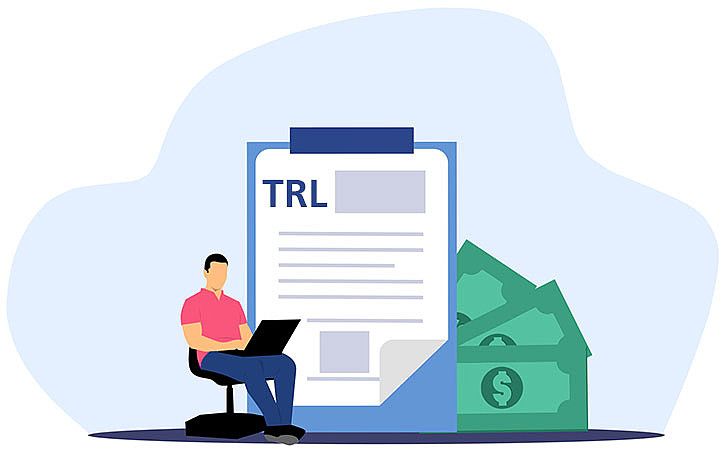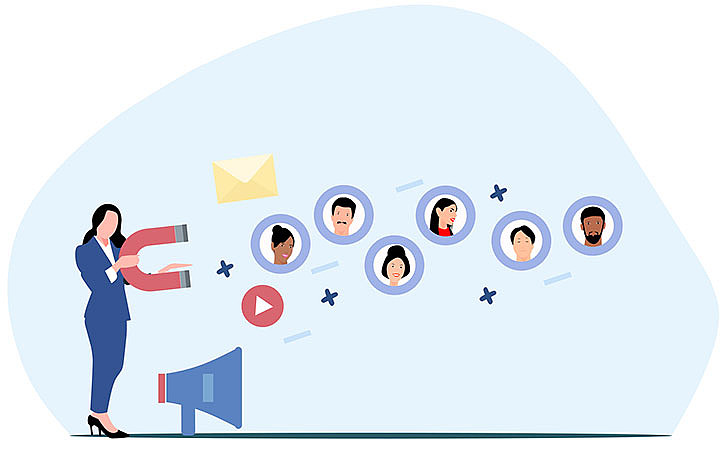Published on December 13, 2022
Checklist: Well prepared for technology transfer

Inventions, know-how and new technical solutions from science can find their way into application via very different paths. You are interested in making your research results usable for others, but you do not know how? The KIT Innovation Management team advises you on your options and accompanies you in your search for industrial partners. The initial exploitation meeting is a first step towards an industrial application of your invention or development. In the confidential discussion between the researcher and the innovation manager, various topics are discussed that have an influence on the chances of exploitation. These include technical details, the development status or the situation at the institute. The better researchers prepare for the meeting and compile the most important key data in advance, the more efficiently questions can be clarified in the meeting. Based on this, a targeted commercialization strategy can be derived.
The following checklist provides an orientation on the core topics in the exploitation meeting:

1. Technology
In order to be able to develop a strategy at all, all parties involved need to understand what they are talking about. Data and facts are the key words. Points such as functional principle, unique selling proposition, as well as advantages and disadvantages compared to the current state of the art are inquired in this context. The quantifiable performance data and key performance indicators (KPI) already available are reviewed and discussed. These key performance indicators could become relevant for marketing activities or in industry discussions.
Key questions about the technology:
- What existing problem does the technology solve? How does it work?
- What is new compared to existing technical solutions?
- Have one or more potential fields of application already been identified?
- What benefits does the technology provide? What added value can users expect?
- Does the technology meet a trend? If so, which one?
- Is the technology easy to track? How easily can an industry partner adapt or replicate it?

2. State of development and planned further development
The central issue here is the technology readiness level (TRL) of the development. It has to be clarified whether a proof-of-concept, a prototype or similar functional proofs of the technology are available, which are a plus point for the search for industrial partners. Current development challenges and further development needs that would be required for industrial usage are also addressed. The planned further development is considered in more detail with regard to time, feasibility and integrability
Key questions on the development status:
- How far has the technology been developed (TRL)? Is there a prototype or demonstrator?
- Are further trials or development steps planned, e.g. as part of a funded or collaborative project?
- If the results are from a funded project: Are there any regulations/obligations towards the sponsor or funder?
- Is there a lively scientific exchange on the development? To what extent has it already been published?
- How much development work and time are still necessary until the product is ready for the market?
- Is the development to be considered as a competing technology? That means, will it displace an existing process or product or is it a novelty (Unique Selling Proposition, USP)?
- What would an industry partner have to bring to the table in order to use or push the technology?
- Are there any special legal regulations that the technology has to pass (e.g. admissions for pharmaceutical products or processes, DIN standard)?

3. Intellectual property
With regard to the granting of rights of use, the question of intellectual property is central. If scientists come to innovation management with a new development, it has to be clarified whether the technology used is already protected by an industrial property right, such as a patent or utility model. Assuming that it is, a closer look is necessary to check whether the claims of the patent still fit the current developments of the invention. Under certain circumstances, new solutions may also be dependent on other patents. In case relevant patents on the technology are already bound in contracts, such as cooperation agreements, the regulations on granted rights of use agreed therein have to be taken into account additionally. After all, further contracts that have already been granted require a delicate touch in order to avoid legal conflicts. Scientists and innovation managers obtain an overall view of the patent situation.
Key questions on intellectual property rights:
- A patent has been applied for (or even already granted) on the technology in countries / regions XYZ: Why do you think patent protection is important in these territories? Examples: Industry players are active there, market segments with territorial reference, existing local contact.
- What exactly is protected in the patent? Examples: Device such as substance/material/product, process and/or use, software.
- Do the claims of the patent still fit the current developments of the invention?
- Does the invention tie in with already patented products or processes? If yes, how does the invention differ from the already existing product or process?
- Which similar technologies from research and industry are known?
- Can the existing property right be circumvented by achieving the same result with a different technology? Would an infringement of property rights be provable?
- Is it necessary to apply for a new property right?

4. Status of economic utilization
In addition to intellectual property, the topics of market potential, imaginable applications and market segments are also important. Due to ongoing research activities, important stakeholders or even concrete industry contacts are often already known in the institute's environment. The exploitation meeting serves to collect existing contacts and to determine potential industry partners that are still unknown. Industry information such as the most important manufacturers and users, established events and meeting places of the target group are also of interest.
Key questions on the object of exploitation:
- Which application area, which market segment should be targeted first in the exploitation? What is the estimated market size (mass market vs. niche market) of this area?
- Which companies are active in the field (big players or SMEs)?
- Are there already industry contacts, e.g. from joint (funded) projects or through conferences, that have expressed interest in the development?
- Are you already in contact with company representatives or do you already cooperate with these industry partners?
- How intense is the competitive and rival situation? Who are the main competitors in the field?
- What has to be demonstrably achieved with the technology so that it can prevail over competing technologies? What technological or monetary advantages does your solution offer over the state of the art?
Bonus: Marktcheck
Scientists are very familiar with the technology they have developed and its technical features. However, in order to be able to evaluate the chances of exploitation, a change of perspective is also important. The basic question: How relevant is the new technology ultimately for potential industrial partners? Therefore, it is helpful to look at what is happening in the market before the exploitation meeting. Market density and volume, necessity or urgency for the market, barriers to market entry, or even a cost-benefit comparison from the company's perspective are important factors in assessing the chances of exploitation.
Giving an initial outlook is not always that easy and can thus also be done in collaboration with the thematically specialized innovation managers. The support provided by IRM can extend to ordering a market analysis. Another possibility to get an assessment from the target market is the focused exchange with the KIT Industry Experts. The KIT network is managed by IRM and offers confidential exchange opportunities with alumni working in the industry, such as online surveys or advisory one-on-one meetings or longer-term consulting.

5. Situation at the institute
Finally, the KIT-internal framework conditions at the institute, such as availability and project experience, are also decisive for success. It is important that the knowledge carrier for the technology either remains at the institute for the foreseeable future or that the succession is secured after the departure. Whether the utilizable technology is currently one of the most important research topics at the institute often plays a role when it comes to providing financial and human resources. Here, the conceivable development costs and a cost-benefit comparison from the KIT's point of view are taken into account. In addition, the most popular forms of cooperation at the institute such as transfer projects (supported by the NEULAND Innovation Fund), public funding projects, or contract research should be considered.
Key questions about the situation:
- Are the knowledge carriers still employed at KIT for a longer period of time?
- What is the situation regarding financial and personnel resources at the institute?
- Is the technology currently one of the most important research topics at the institute or will it be integrated into the development topics in the future?
- Is there a research team that can/will deal with the topic in the longer term?
- Can you imagine further development in collaboration with a company and what advantages or disadvantages do you see for you or your institute?
- What are the institute's most popular forms of cooperation?
- What form of technology transfer are you aiming for? Examples: Spin-off, licensing, research project, etc.

6. Technology Marketing
Once a concrete exploitation target emerges from the information gathered so far, targeted communication to potential partners gets into play. Innovation management offers support in the areas of marketing and sales via the RESEARCH TO BUSINESS platform with digital formats, events, support for trade fair appearances and much more. In the exploitation meeting, possible marketing activities for the respective identified market segments are considered and sources of information and contact persons for foreseeable activities are discussed.
Key marketing questions:
- What information can the research group provide?
- What effective publicity activities have already been done by the institute or even specifically on the technology? Examples: Publications, events, social media, podcasts or videos, etc.
- Who would be the technical contact for the technology marketing team, e.g., to create technology offers?
- How active are you or the research group on social media?
- What trade media are typically read in your field? Through what channels can the target audience be reached?
- Has the development already been presented at trade shows or expert conferences? If so, at which ones?
- Which relevant trade fairs or congresses on the topic are known?
Many questions worth answering. The preliminary considerations help to become clearer about one's own research work and its economic applicability. In addition, the chances of successful technology transfer are much better with a targeted valorization plan. Nevertheless, the questions do not have to be answered completely in order to approach IRM. The initial exploitation meeting is characterized by the exchange between researchers and innovation managers. Afterwards, it is important that both sides pull together. The Innovation Management team offers KIT scientific employees strategic and operational support in finding one or more partners from industry. If you have any questions about technology transfer, the innovation management team will be pleased to help you.

comments about this article
No comments